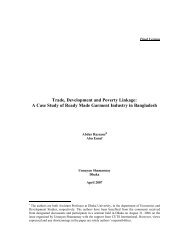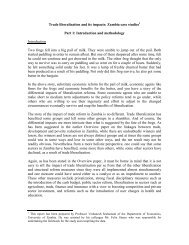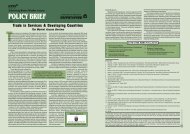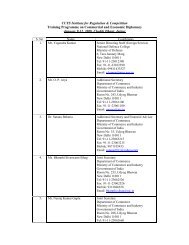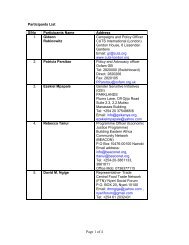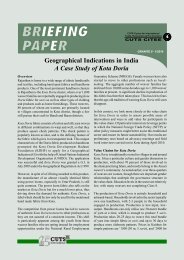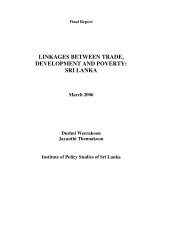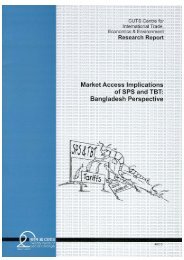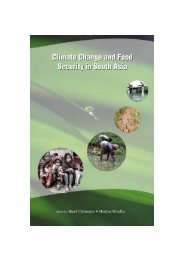What is its role in tackling poverty? - cuts citee
What is its role in tackling poverty? - cuts citee
What is its role in tackling poverty? - cuts citee
- No tags were found...
You also want an ePaper? Increase the reach of your titles
YUMPU automatically turns print PDFs into web optimized ePapers that Google loves.
Trade capacity constra<strong>in</strong>ts <strong>in</strong> the poor countriesThe mixed experiences of many develop<strong>in</strong>g countries <strong>in</strong>response to trade liberal<strong>is</strong>ation over the last two decadeshas spawned a lively and often fractious debate as to thew<strong>is</strong>dom of orthodox approaches to trade reform, whichemphas<strong>is</strong>es trade liberal<strong>is</strong>ation as the predom<strong>in</strong>ant vehiclefor stimulat<strong>in</strong>g trade expansion. It has been argued that arange of <strong>in</strong>stitutional, economic and structural supply-sideconstra<strong>in</strong>ts are creat<strong>in</strong>g obstacles to trade expansion <strong>in</strong> thepoor countries and limit<strong>in</strong>g the efforts of economic agentsto take advantage of the opportunities provided by privatetrad<strong>in</strong>g and improved market access.The supply-side constra<strong>in</strong>ts fac<strong>in</strong>g develop<strong>in</strong>g countriesare numerous, but the most common and significant are oftenquoted as: transport <strong>in</strong>frastructure weaknesses (<strong>in</strong>clud<strong>in</strong>groads, railways, ports and aviation facilities); power andtelecommunications <strong>in</strong>frastructure weaknesses; humanresource and skills shortages; technological deficiencies; weakf<strong>in</strong>ancial sectors and a shortage of credit; weak property rights;TDP 5/2007Integrated Framework for Trade Related Ass<strong>is</strong>tance<strong>What</strong> <strong>is</strong> <strong>its</strong> <strong>role</strong> <strong>in</strong> tackl<strong>in</strong>g <strong>poverty</strong>?Gideon Rab<strong>in</strong>owitz*The supply-side constra<strong>in</strong>ts that are hamper<strong>in</strong>g the efforts of the poor countries to respond to new trad<strong>in</strong>g opportunitiesare gett<strong>in</strong>g <strong>in</strong>creased attention <strong>in</strong> Poverty Reduction Strategy Papers (PRSPs) and the World Trade Organ<strong>is</strong>ation(WTO) Aid for Trade agenda. One of the facilities that <strong>is</strong> be<strong>in</strong>g util<strong>is</strong>ed by the least developed countries (LDCs) toidentify trade capacity build<strong>in</strong>g priorities <strong>is</strong> the donor funded multi agency Integrated Framework (IF) for TradeRelated Technical Ass<strong>is</strong>tance (TRTA). Th<strong>is</strong> facility <strong>is</strong> be<strong>in</strong>g manoeuvred to play a crucial <strong>role</strong> <strong>in</strong> <strong>in</strong>tegrat<strong>in</strong>g trade <strong>in</strong>toPRSPs and guid<strong>in</strong>g the Aid for Trade process.However, s<strong>in</strong>ce <strong>its</strong> launch <strong>in</strong> 1997, IF has faced a range of entrenched problems, <strong>in</strong>clud<strong>in</strong>g limited ownership by LDCsand weak management. Th<strong>is</strong> policy brief exam<strong>in</strong>es the neglect and constra<strong>in</strong>ts <strong>in</strong> trade capacity build<strong>in</strong>g <strong>in</strong> the poorcountries and analyses the IF process, <strong>in</strong>clud<strong>in</strong>g <strong>its</strong> weaknesses and ongo<strong>in</strong>g reforms followed by specific recommendations.Table 1: Infrastructure Indicators for AfricanAsian and Island LDCsTelephone ma<strong>in</strong>l<strong>in</strong>esper 1000 peopleElectrificationrate (%)Paved roads as% of totalInternet price as% of GN% of energy fromYear20032002199920032002African LDCs9.014.215.535578.5Asian LDCs13.421.326.713068.0Island LDCs61.2-48.5132-traditional sourcesSource: UNCTAD LDC report 2006, chapter 5* Campaigns and Policy Officer, CUTS International (London)<strong>in</strong>effective and harmful regulation; <strong>in</strong>efficient customsfacilities and procedures; and weak trade related <strong>in</strong>stitutions.Neglect of trade capacity build<strong>in</strong>gOne of the reasons why develop<strong>in</strong>g country policymakersand development agencies have begun to pressfor greater attention to tackl<strong>in</strong>g supply-side constra<strong>in</strong>ts <strong>is</strong>the fact that th<strong>is</strong> has been neglected by the develop<strong>in</strong>gcountry governments and the donor community.S<strong>in</strong>ce early 1980s, many develop<strong>in</strong>g countries have beenencouraged to reduce government spend<strong>in</strong>g to improvepublic f<strong>in</strong>ances, and to d<strong>is</strong>tance themselves from gett<strong>in</strong>g<strong>in</strong>volved <strong>in</strong> private trad<strong>in</strong>g. These reforms have beenaccompanied by a trend of fall<strong>in</strong>g <strong>in</strong>vestment on economic<strong>in</strong>frastructure, as can be illustrated by the estimated fall <strong>in</strong> theproportion of gross domestic product (GDP) between 1980and 1998, from six to four percent <strong>in</strong> Africa; from 12 to five <strong>in</strong>Asia; and from 11 percent to six percent <strong>in</strong> Lat<strong>in</strong> America. Inthe poor countries, th<strong>is</strong> trend has been even more marked,with five of the 13 LDCs hav<strong>in</strong>g spent less than one percentof GDP on economic <strong>in</strong>frastructure <strong>in</strong> the second half of the1990s, and seven hav<strong>in</strong>g spent less than two percent. 1A similar trend has also been observed <strong>in</strong> officialdevelopment ass<strong>is</strong>tance (ODA) spend<strong>in</strong>g over the last twodecades, as donors have priorit<strong>is</strong>ed the prov<strong>is</strong>ion of aid tofund social sector <strong>in</strong>vestment over <strong>in</strong>frastructure. Between1992 and 2003, aid for social <strong>in</strong>frastructure and services <strong>in</strong> theLDCs <strong>in</strong>creased by 14.6 percent per annum <strong>in</strong> nom<strong>in</strong>al terms,whilst aid for economic <strong>in</strong>frastructure <strong>in</strong>creased by a merethree percent over the whole period. In real terms, <strong>in</strong> 2003,aid for <strong>in</strong>frastructure was 51 percent lower than that <strong>in</strong> 1992. 2In response to the importance of develop<strong>in</strong>g economic<strong>in</strong>frastructure <strong>in</strong> the poor countries, governments and donorsare attempt<strong>in</strong>g to re-emphas<strong>is</strong>e such <strong>in</strong>vestments. In order tomobil<strong>is</strong>e and direct <strong>in</strong>vestment, develop<strong>in</strong>g countryMINBUZAM<strong>in</strong><strong>is</strong>try of Foreign Affairs,The NetherlandsWith the support of&DFIDDepartment forInternationalDevelopment,UK
Table 2: Trade Content <strong>in</strong> First Generation PRSPs of Select African CountriesCountry Burk<strong>in</strong>o Faso Ethiopia Malawi Mozambique Rwanda Tanzania UgandaIdentifiable section <strong>in</strong>PRSP relat<strong>in</strong>g to trade? No Yes Yes Yes No No NoDoes the analys<strong>is</strong> on trade relateback to the <strong>poverty</strong> analys<strong>is</strong>? No No No Yes No Yes Nogovernments and donors have been work<strong>in</strong>g together todiagnose supply-side constra<strong>in</strong>ts and to <strong>in</strong>corporate<strong>in</strong>terventions to tackle them <strong>in</strong>to national development plans.Th<strong>is</strong> has <strong>in</strong>cluded an emphas<strong>is</strong> on the need to expand thefocus of PRSPs. In addition, develop<strong>in</strong>g countries have alsobeen us<strong>in</strong>g their engagement with <strong>in</strong>ternational fora such asthe UN and the WTO to mobil<strong>is</strong>e <strong>in</strong>creased donor support to<strong>in</strong>vest <strong>in</strong> trade capacity. At the UN Millennium Summit and laterat the Monterrey Conference develop<strong>in</strong>g countries made a pleafor <strong>in</strong>creased aid to tackle the full array of development constra<strong>in</strong>ts.The IF for TRTA to LDCsOne of the most significant multilateral facilities currentlybe<strong>in</strong>g used by develop<strong>in</strong>g countries and donors toidentify trade-related ass<strong>is</strong>tance priorities <strong>is</strong> the IF for TRTAto LDCs. Th<strong>is</strong> facility was establ<strong>is</strong>hed by the majormultilateral agencies work<strong>in</strong>g on TRTA, such as InternationalMonetary Fund (IMF), International Trade Centre (ITC),United Nations Conference on Trade and Development(UNCTAD), United Nations Development Progamme (UNDP),World Bank and WTO <strong>in</strong> 1997 to ass<strong>is</strong>t LDCs <strong>in</strong> <strong>in</strong>tegrat<strong>in</strong>g<strong>in</strong>to the global economy. The IF aims to deliver TRTA toparticipat<strong>in</strong>g LDCs through the follow<strong>in</strong>g three phases:• Preparatory phase: Includes an official request from thecountry to participate <strong>in</strong> the IF process; a technicalreview of the request; the establ<strong>is</strong>hment of the NationalIF steer<strong>in</strong>g committee; and the identification of a lead donor.• Diagnostic phase: It results <strong>in</strong>to the elaboration ofDiagnostic Trade Integration Study (DTIS), which <strong>is</strong>supposed to be a comprehensive assessment of the tradepolicy and trad<strong>in</strong>g environment.• Follow-up phase: Cons<strong>is</strong>ts of the translation of diagnosticphase’s f<strong>in</strong>d<strong>in</strong>gs <strong>in</strong>to the elaboration and validation ofan action plan, which serves as bas<strong>is</strong> for TRTA delivery.Expanded mandate of the IFAlthough orig<strong>in</strong>ally charged with the mandate ofimprov<strong>in</strong>g the coord<strong>in</strong>ation and effectiveness of TRTAdelivery of the six fund<strong>in</strong>g agencies, the mandate of the IFhas expanded both conceptually and practically s<strong>in</strong>ce <strong>its</strong>establ<strong>is</strong>hment <strong>in</strong> 1997. Follow<strong>in</strong>g the <strong>in</strong>itial phase of <strong>its</strong>operation a 2000 evaluation 3 of the IF concluded that thetechnical ass<strong>is</strong>tance provided was <strong>in</strong>effective, due to weakgovernance structure. The evaluation also concluded thatneeds assessments had attracted little attention from LDCgovernments and donors.In response, IF was revamped <strong>in</strong> 2001, with the newpriorities emphas<strong>is</strong>ed by the manag<strong>in</strong>g agencies be<strong>in</strong>g anexpanded focus on the constra<strong>in</strong>ts faced <strong>in</strong> external markets2and the need forDTISs/actionmatrices to play a lead<strong>role</strong> <strong>in</strong> <strong>in</strong>tegrat<strong>in</strong>gtrade <strong>in</strong>to the PRSPs.In response todemands bydevelop<strong>in</strong>g countriesfor the Doha Round tomobil<strong>is</strong>e greater traderelated ass<strong>is</strong>tance tosupport trade development, WTO members endorsed theestabl<strong>is</strong>hment of Task Forces on IF and Aid for Trade to explorehow such ass<strong>is</strong>tance could be improved. The IF Task Forcerecommended that an Enhanced IF be establ<strong>is</strong>hed with improvedprocedures and <strong>in</strong>creased volumes of f<strong>in</strong>ance. The Aid for TradeTask Force recommended that “the recommendations on anenhanced IF…will be an essential foundation for strengthen<strong>in</strong>gthe demand-side of Aid for Trade <strong>in</strong> LDCs”. The Enhanced IF <strong>is</strong>,therefore, be<strong>in</strong>g manoeuvred to play a lead<strong>in</strong>g <strong>role</strong> <strong>in</strong> the PRSPprocess and <strong>in</strong> mobil<strong>is</strong><strong>in</strong>g Aid for Trade to f<strong>in</strong>ance prioritysupport areas for LDCs. Moreover, it will play an <strong>in</strong>creas<strong>in</strong>gly<strong>in</strong>fluential <strong>role</strong> <strong>in</strong> guid<strong>in</strong>g the response of the <strong>in</strong>ternationalcommunity to trade development <strong>in</strong> the poor countries.Does the PRSP d<strong>is</strong>cuss tradepolicy options explicitly Yes Yes Yes Yes Yes Yes NoSource: A review of the trade and <strong>poverty</strong> content <strong>in</strong> PRSPs and loan-related documents, ODI, 2003Ongo<strong>in</strong>g weaknesses of the IFThe most recent evaluation 4 of IF was undertaken <strong>in</strong> 2004and highlighted a wide range of weaknesses <strong>in</strong>clud<strong>in</strong>g• Lack of ownership: As IF has been perceived as donordriven, <strong>in</strong>-country stakeholders (<strong>in</strong>clud<strong>in</strong>g m<strong>in</strong><strong>is</strong>tries,private sector and civil society) have faced political andcapacity constra<strong>in</strong>ts and outcomes have only beenma<strong>in</strong>streamed <strong>in</strong>to policy-mak<strong>in</strong>g processes (e.g. PRSP,national development plans).• Poor management: LDCs, donors and the establ<strong>is</strong>h<strong>in</strong>gagencies have found it difficult to mobil<strong>is</strong>e the humanresources and expert<strong>is</strong>e to effectively manage the facilityand there has been poor coord<strong>in</strong>ation and unclearmandates for the agencies <strong>in</strong>volved.• Lack of f<strong>in</strong>ance: Diagnostic studies have now been donefor over 20 countries each of which has only receivedUS$4mn for implementation. Donors have been slow tocommit resources to the IF.• Scope of facility: Until now, IF has dealt with quite anarrow range of TRTA needs limit<strong>in</strong>g <strong>its</strong> ability tocontribute to wider trade related needs.In addition, ex<strong>is</strong>t<strong>in</strong>g DTISs and Action Matrices exhibita common approach which <strong>in</strong>cludes the follow<strong>in</strong>g elements:Ø A predom<strong>in</strong>ant focus on export sectors, with little (if any)focus on the domestic sector. Th<strong>is</strong> <strong>is</strong> most pronouncedfor agriculture, where cash crops receive significantattention but food crops receive almost none.Ø Limited focus on <strong>in</strong>dustrial development, with a focuson develop<strong>in</strong>g primary production and basic process<strong>in</strong>gpriorit<strong>is</strong>ed (especially horticulture and floriculture)justified by theories of static comparative advantage.Th<strong>is</strong> <strong>is</strong> even the case <strong>in</strong> countries where (proto) <strong>in</strong>dustryprovides many jobs and <strong>is</strong> <strong>in</strong>creas<strong>in</strong>gly ga<strong>in</strong><strong>in</strong>g new(ma<strong>in</strong>ly regional markets), e.g. Tanzania and Uganda.
Ø Privat<strong>is</strong>ation proposed <strong>in</strong> agriculture (and other sectors),with ongo<strong>in</strong>g difficulties faced by agricultural sectorsblamed on state <strong>in</strong>volvement and such reforms proposedwithout any d<strong>is</strong>cussion of alternative options and limitedfocus on <strong>in</strong>terventions to promote farmer empowerment.Ø Technocratic approach to trade, with the ma<strong>in</strong> emphas<strong>is</strong>be<strong>in</strong>g on improv<strong>in</strong>g the bus<strong>in</strong>ess climate <strong>in</strong> the formalsector (through improv<strong>in</strong>g regulations, customs facilities,trade support <strong>in</strong>stitutions etc) and neglect of analys<strong>is</strong> on<strong>in</strong>formal sector needs.Ø Poorly <strong>in</strong>tegrated and narrow response to <strong>poverty</strong>, with asection on trade and <strong>poverty</strong> <strong>in</strong>cluded separately fromanalys<strong>is</strong> on sectoral and cross cutt<strong>in</strong>g <strong>is</strong>sues andeconomic growth, improved market access and gett<strong>in</strong>gprices right presented as the predom<strong>in</strong>ant channel forl<strong>in</strong>k<strong>in</strong>g trade and <strong>poverty</strong>. 5Although some of these policy approaches are importantfor LDCs to consider, the concern <strong>is</strong> that they are presented<strong>in</strong> DTISs/Action Matrices with little qualify<strong>in</strong>g analys<strong>is</strong> andno alternative approaches. Th<strong>is</strong> leads many to conclude thatthe IF <strong>is</strong> simply another way for donors to cont<strong>in</strong>ue push<strong>in</strong>gand neo-liberal trade agenda under the gu<strong>is</strong>e of trade capacitybuild<strong>in</strong>g. 6 The conceptual and policy approach taken by theDTIS’s and Action Matrices <strong>is</strong> to some degree a legacy ofthe IF’s orig<strong>in</strong>al mandate which was to support LDCs toachieve WTO compliance and <strong>in</strong>tegrate <strong>in</strong>to the globaleconomy through export development.The character of the IF outputs to date <strong>is</strong> also to somedegree a function of the World Bank’s ongo<strong>in</strong>g dom<strong>in</strong>ance ofthe process and the <strong>in</strong>fluence of <strong>its</strong> approach to trade reform.The World Bank <strong>is</strong> commonly perceived as hav<strong>in</strong>g the mostsignificant <strong>in</strong>-country capacity and expert<strong>is</strong>e on trade. It has,therefore, taken a lead <strong>in</strong> manag<strong>in</strong>g the DTIS process and <strong>is</strong>heavily <strong>in</strong>volved <strong>in</strong> all aspects, <strong>in</strong>clud<strong>in</strong>g: assess<strong>in</strong>g applicants;develop<strong>in</strong>g terms of reference for studies; provid<strong>in</strong>gconsultants for the studies; and review<strong>in</strong>g and validat<strong>in</strong>g thef<strong>in</strong>al studies. Its <strong>in</strong>-country resource and expert<strong>is</strong>e advantagehas allowed it to dom<strong>in</strong>ate the IF process with the <strong>role</strong> ofagencies such UNDP be<strong>in</strong>g reduced to “no more than a trifle”. 7Box 1: DTIS Framework Used by World BankOverall trade <strong>is</strong>sues• Macroeconomic environment• Structure and pattern of trade and <strong>in</strong>vestment• Trade policy and <strong>in</strong>stitutions• Trade agreements and market access• WTO accession if applicable• Trade and <strong>poverty</strong>Cross-cutt<strong>in</strong>g <strong>is</strong>sues• Bus<strong>in</strong>ess environment and <strong>in</strong>stitutional framework for trade and<strong>in</strong>vestment• Trade facilitation• StandardsSectoral studies• Review of sectors and sub-sectors, <strong>in</strong>clud<strong>in</strong>g production levels,constra<strong>in</strong>ts faced, scope for <strong>in</strong>creased production, prospects for <strong>poverty</strong>reduction, proposals to tackle constra<strong>in</strong>tsOngo<strong>in</strong>g review and reform of the IFIn response to these challenges further efforts have beenmade and of most relevance <strong>is</strong> the work of the WTOmandatedIF Task Force which led by Ambassador DonStephenson (Canada) who reviewed the operation of the IFand made recommendations for improv<strong>in</strong>g <strong>its</strong> effectiveness.The IF Task Force and <strong>its</strong> successor the IF Transition Teamhave recommended that an Enhanced-IF be establ<strong>is</strong>hed thatwould <strong>in</strong>clude the follow<strong>in</strong>g elements:• National Implementation Unit (NIU): Each IF countrywould establ<strong>is</strong>h a NIU to br<strong>in</strong>g together donors andrecipients to support IF implementation (with human andphysical resources) and receive money forimplementation. The NIU would be managed by a HighLevel M<strong>in</strong><strong>is</strong>terial committee.• Independent Trust Fund: Th<strong>is</strong> will sit <strong>in</strong> the WTO (andreceive adm<strong>in</strong><strong>is</strong>trative support) but be entirely<strong>in</strong>dependent. The Trust Fund will be managed by the IFBoard cons<strong>is</strong>t<strong>in</strong>g of three LDCs, three donors, withestabl<strong>is</strong>h<strong>in</strong>g agencies as observers.• F<strong>in</strong>ance: It has been recommended that IF should beprovided with US$400mn over the next five years, i.e. 80percent of th<strong>is</strong> for capacity build<strong>in</strong>g, 17 percent for DTISsand three percent for the IF Secretariat.• Role of IF agencies: Participat<strong>in</strong>g countries can choosetheir preferred agency to take a lead <strong>in</strong> engag<strong>in</strong>g them <strong>in</strong>the process (previously the agencies were chosen forthem), so that they can choose those which best respondto their needs.• Scope of facility: In order to respond to the Aid for TradeAgenda, IF will expand <strong>its</strong> focus to <strong>in</strong>clude a wide rangeof trade related ass<strong>is</strong>tance needs, <strong>in</strong>clud<strong>in</strong>g<strong>in</strong>frastructure.Elements such as the NIUs and the freedom of IF partnersto choose the agencies with which to engage are designedto support LDCs <strong>in</strong> ga<strong>in</strong><strong>in</strong>g ownership of the IF processand reduc<strong>in</strong>g the <strong>in</strong>fluence of <strong>in</strong>dividual donors/agencies.The Enhanced-IF package was approved by the IF Board <strong>in</strong>May 2006, and d<strong>is</strong>cussions are go<strong>in</strong>g on how to put th<strong>is</strong><strong>in</strong>to operation. A major donor meet<strong>in</strong>g <strong>is</strong> planned forSeptember 25, 2007, which will be used to mobil<strong>is</strong>e thesupport required to fund the Enhanced-IF. The UKGovernment, a long time backer of the IF process has alreadypledged to fund 20 percent of <strong>its</strong> total budget, equivalent toup to US$80mn if Enhanced-IF’s budget <strong>is</strong> fully funded.Significant rema<strong>in</strong><strong>in</strong>g challengesDespite the bold and quite progressive v<strong>is</strong>ion of the IFTask Force and Transition Teams, a number of questionsrema<strong>in</strong> unanswered v<strong>is</strong>-à-v<strong>is</strong> the recommendations and <strong>is</strong>suesthat have not been addressed by the IF review process.These <strong>is</strong>sues have major significance <strong>in</strong> facilitat<strong>in</strong>g theoperation of IF they need to be urgently addressed.1) How to ensure that LDC’s take advantage of the newflexibilities and <strong>in</strong>novations of the Enhanced-IF?There certa<strong>in</strong>ly appear to be new spaces for LDCs toassert their ownership of the IF process. However, <strong>its</strong>hould not be assumed that these spaces will be takenadvantage of, due to limited knowledge amongst <strong>in</strong>countrystakeholders about the IF process, <strong>in</strong>-countrycapacity constra<strong>in</strong>ts and the cont<strong>in</strong>u<strong>in</strong>g dom<strong>in</strong>ance ofthe World Bank to work.3
Table 3: Task Force Fund<strong>in</strong>g Recommendations for Diagnostic ActivitiesPer LDC No. of LDCs Total cost$ No. $ $Pre-DTIS support 50,000 1 50,000 20 1,000,000DTIS 400,000 1 400,000 20 8,000,000Support to focal po<strong>in</strong>t 300,000 5 1,500,000 40 60,000,000DTIS updates 100,000 2 200,000 40 8,000,000Total 77,000,000Source: Recommendations of IF Task Force2) How to create spaces with<strong>in</strong> the IF process for nonstateactors (<strong>in</strong>clud<strong>in</strong>g private sector and civil society)to play a significant <strong>role</strong>?To date there has been <strong>in</strong>credibly little engagement withnon-state actors (NSAs) such as the private sector andcivil society groups with the IF process. Th<strong>is</strong> <strong>is</strong> due to theoften short period allotted to IF m<strong>is</strong>sions, poor transparencyof the process and lack of political will amongst donorsand recipient governments. Th<strong>is</strong> threatens to leave the IFprocess d<strong>is</strong>engaged from economic and social realitiesfaced by people and poses the question as to what needsto be done to create and ma<strong>in</strong>ta<strong>in</strong> these spaces.3) How to effectively <strong>in</strong>tegrate a trade-<strong>poverty</strong> perspective<strong>in</strong>to the diagnostic studies and the follow-up phase?The assessment of IF outputs presented <strong>in</strong> th<strong>is</strong> papersuggests that the analys<strong>is</strong> and action plans producedare not sufficiently l<strong>in</strong>ked to analys<strong>is</strong> of <strong>poverty</strong> andbroader development ass<strong>is</strong>tance and <strong>poverty</strong> reductionprogrammes. Th<strong>is</strong> poses some significant questionsabout how such analys<strong>is</strong> and <strong>in</strong>tegrated trade-<strong>poverty</strong>action plans can be developed.4) How donors will util<strong>is</strong>e their engagement with theEnhanced-IF to encourage the manag<strong>in</strong>g agencies tocreate a more open debate on trade policy anddevelopment <strong>in</strong> LDCs?The <strong>in</strong>ternational agencies manag<strong>in</strong>g the IF are fundedby donors and are supposed to respond to an agendadef<strong>in</strong>ed by them. The World Bank (and others) will onlytake alternative approaches to trade capacity build<strong>in</strong>g ifdonor agencies are prepared to <strong>in</strong>vest political capital <strong>in</strong>ensur<strong>in</strong>g that processes such as the IF are suitablytransparent, open and participatory. Th<strong>is</strong> poses somesignificant questions about how bilateral donors shouldengage with the IF process and monitor <strong>its</strong> function<strong>in</strong>g.EndnotesRecommendationsWith many adm<strong>in</strong><strong>is</strong>trative, operational and<strong>in</strong>stitutional matters of the Enhanced-IF settled, there <strong>is</strong> now an opportunity to addressthese fundamental questions and to encouragethose lead<strong>in</strong>g the IF process to consider themfully. It <strong>is</strong> also important that stakeholders fromacross the development community take theopportunity to feed <strong>in</strong>to th<strong>is</strong> debate which <strong>is</strong>tak<strong>in</strong>g place at a crucial po<strong>in</strong>t <strong>in</strong> the IF’sdevelopment. Below are a number of generalrecommendations <strong>in</strong> response to the questions posed above:1 Tak<strong>in</strong>g advantage of new spaces: It <strong>is</strong> important for IFagencies and partners to take pro-active measures toensure that the obstacles to improved ownership aredealt with through <strong>in</strong>formation d<strong>is</strong>sem<strong>in</strong>ation, long termmanagement at the country level and an improvedemphas<strong>is</strong> on the <strong>role</strong> of a wider range of agencies.2 Ensur<strong>in</strong>g active participation: It <strong>is</strong> important that the IFprocess <strong>in</strong>cludes pro-active consultation with NSAs asstandard (rather than the exception) and that engagementwith these groups <strong>is</strong> priorit<strong>is</strong>ed at all stages of the process,<strong>in</strong>clud<strong>in</strong>g develop<strong>in</strong>g Terms of References (ToRs),choos<strong>in</strong>g agencies, research and validation etc. Longerm<strong>is</strong>sions and consultation periods could also play animportant <strong>role</strong> here.3 Support<strong>in</strong>g NSAs to engage: It <strong>is</strong> important for the IFagencies, partners and recipient governments to play apro-active <strong>role</strong> <strong>in</strong> d<strong>is</strong>sem<strong>in</strong>at<strong>in</strong>g accessible <strong>in</strong>formationto NSAs about the IF process and that they providesupport to a wide range of stakeholder groups to play anactive <strong>role</strong> <strong>in</strong> IF activities.4 L<strong>in</strong>k<strong>in</strong>g trade and <strong>poverty</strong> <strong>is</strong> a challenge which <strong>is</strong> notd<strong>is</strong>t<strong>in</strong>ctly unlike the challenge that faced (and still faces)policy-makers <strong>in</strong> the PRSPs process. The significant (andongo<strong>in</strong>g) <strong>in</strong>vestment by donors and recipient countries<strong>in</strong> improv<strong>in</strong>g <strong>poverty</strong> related analys<strong>is</strong> to feed <strong>in</strong>to thePRS should be <strong>in</strong>dicative of the long term <strong>in</strong>vestment.Th<strong>is</strong> effort needs to take place across the <strong>in</strong>ternationalcommunity and <strong>in</strong>volve multi-d<strong>is</strong>cipl<strong>in</strong>ary approachesand an open debate. DTISs and Action Matrices shouldalso rema<strong>in</strong> open to be<strong>in</strong>g reviewed and rev<strong>is</strong>ed, like PRSPs.5 Open<strong>in</strong>g donor debate whereby donors should play anactive <strong>role</strong> <strong>in</strong> ensur<strong>in</strong>g that Enhanced-IF <strong>is</strong> implemented<strong>in</strong> a transparent, open and participatory fashion so thatLDCs can explore the full range of strategies.1 UNCTAD LDC Report, 2006, chapter 5C2 Ibid3 “Review of the Integrated Framework for Technical Ass<strong>is</strong>tance for Trade Development of LDCs”, OED, World Bank, 20004 “An <strong>in</strong>dependent evaluation of the Integrated Framework for Trade Related Technical Ass<strong>is</strong>tance”, IEG, World Bank, 20045 These conclusions are echoed by reviews of other TRTA programmes (both bilateral and multilateral), for example see “Trade-RelatedAss<strong>is</strong>tance <strong>What</strong> Do Recent Evaluations Tell Us?”, OECD, 20076 “Corner<strong>in</strong>g the market: The World Bank and trade capacity build<strong>in</strong>g”, Bretton Woods Project, 20027 IbidTh<strong>is</strong> Brief<strong>in</strong>g Paper has been produced by CUTS Centre for International Trade, Economics & Environment under the project ‘L<strong>in</strong>kages between Trade,Development & Poverty Reduction’ (TDP) funded by M<strong>in</strong><strong>is</strong>try of Foreign Affairs (MINBUZA), The Netherlands and Department for International Development(DFID), UK. The views expressed <strong>in</strong> th<strong>is</strong> paper are those of the author and therefore, <strong>in</strong> no way be taken to reflect that of MINBUZA, The Netherlands and DFID, UK.© CUTS International, 2007. Th<strong>is</strong> Brief<strong>in</strong>g Paper <strong>is</strong> publ<strong>is</strong>hed by CUTS Centre for International Trade, Economics & Environment(CUTS CITEE), D-217, Bhaskar Marg, Bani Park, Jaipur 302 016, India. Ph: 91.141.228 2821, Fx: 91.141.228 2485, E-mail: <strong>citee</strong>@<strong>cuts</strong>.org,Web Site: www.<strong>cuts</strong>-<strong>in</strong>ternational.org/www.<strong>cuts</strong>-<strong>citee</strong>.org. CUTS Brief<strong>in</strong>g Papers are to <strong>in</strong>form, educate and provoke debate on specific <strong>is</strong>sues.Readers are encouraged to quote or reproduce material from th<strong>is</strong> paper for their own use, but CUTS International requests due acknowledgementand a copy of the publication.CUTS CITEE




